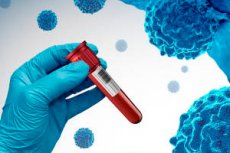New ultra-sensitive blood test predicts breast cancer recurrence months or years before it returns
Last reviewed: 14.06.2024

All iLive content is medically reviewed or fact checked to ensure as much factual accuracy as possible.
We have strict sourcing guidelines and only link to reputable media sites, academic research institutions and, whenever possible, medically peer reviewed studies. Note that the numbers in parentheses ([1], [2], etc.) are clickable links to these studies.
If you feel that any of our content is inaccurate, out-of-date, or otherwise questionable, please select it and press Ctrl + Enter.

A recent study found that a new type of blood test can predict breast cancer recurrence in high-risk patients months or even years before it returns.
A team from the Institute of Cancer Research London used ultra-sensitive liquid biopsy to detect small traces of cancer DNA in the body after treatment for early-stage breast cancer.
The results, presented at the annual meeting of the American Society of Clinical Oncology (ASCO) in Chicago on June 2, included analysis of blood samples from the ChemoNEAR study for the presence of circulating tumor DNA (ctDNA)., which cancer cells secrete into the blood.
Researchers at the Toby Robins Breast Cancer Research Center at the Institute of Cancer Research London were able to identify all patients who later relapsed by detecting very low levels of cancer DNA in the blood, known as molecular residual disease.
Detection of a large number of cancer mutations
By trying to identify patients most likely to relapse, scientists hope the results will help develop a new strategy for treating recurrent breast cancer, allowing treatment to begin much earlier, without waiting for the development of incurable disease visible on scans.
Although previous studies have shown that ctDNA blood tests can detect a relapse long before it is detected on a scan, most tests use whole exome sequencing (WES), which focuses on exons - regions of protein-coding genes directly linked to diseases.
This study used whole genome sequencing (WGS), which allowed scientists to detect up to 1,800 mutations, significantly increasing the sensitivity of the method and allowing them to detect more cancerous changes in a patient's DNA.
Blood samples and test results
Blood samples from 78 patients with various types of early breast cancer (23 with triple-negative breast cancer, 35 with HER2+ breast cancer, 18 with hormone receptor-positive breast cancer, and two with unknown subtype) were tested for the presence of ctDNA.
Samples were collected from women at diagnosis, before initiation of therapy, after the second cycle of chemotherapy, after surgery, and every three months during the first year of follow-up. Samples were then collected every six months for the next five years.
Identifying patients most likely to relapse
The results showed that detection of ctDNA at any time postoperatively or during follow-up was associated with a high risk of future relapse and decreased overall survival.
Molecular residual disease was detected in all 11 patients who relapsed. The median time to clinical recurrence in this group of patients was 15 months, an increase of three months compared with current testing for all types of breast cancer. The maximum time to clinical relapse was 41 months.
None of the 60 women in whom ctDNA was not detected experienced a relapse during the follow-up period. Three patients had ctDNA detected during follow-up but did not experience relapse by the end of the study. The median survival for patients with detected ctDNA was 62 months, and for patients in whom ctDNA was not detected, median survival was not reached.
Prospects and further research
“This proof-of-concept retrospective study lays the foundation for better post-treatment monitoring and potentially life-prolonging treatments for patients,” said Dr Isaac Garcia-Murillas, a research fellow in the molecular oncology group at the Institute of Cancer Research London.
"Cancer cells may remain in the body after surgery and other treatments, but there may be so few of them that they are not detected in subsequent scans. These cells can cause breast cancer to recur in patients many years after initial treatment. Ultrasensitive tests blood may offer a better approach for long-term monitoring of patients at high risk of relapse," he added.
Professor Nicholas Turner, Professor of Molecular Oncology at the London Institute of Cancer Research and consultant oncologist at The Royal Marsden NHS Foundation Trust, said: "Testing a patient's blood for ctDNA will allow clinicians to diagnose cancer returning at a very early stage. However, more research is needed and testing so that we can demonstrate that detection of molecular residual disease can guide future therapy."
Professor Christian Helin, Director General of the London Institute of Cancer Research, added: “Breast cancer is much easier to treat before it spreads to other parts of the body, so it is vital that we are able to detect signs of recurrence of the disease as early as possible to give people the best chance of survival. "
"It's exciting to see technological advances that can detect cancer cells and DNA with greater sensitivity to detect residual disease or early signs of breast cancer recurrence when a cure is still possible," he said.
Dr Simon Vincent, director of research, support and impact at Breast Cancer Now, said: “Early detection is one of our greatest weapons against breast cancer and these initial results suggest new tests can detect signs of cancer recurrence breasts more than a year before symptoms appear is incredibly reassuring."
Dr Richard Chan, Chief Medical Officer and Executive Vice President of Research and Development at Personalis, said: “We are delighted to be working with Professor Turner, Dr Garcia-Murillas and other leaders in breast cancer at the London Institute of Cancer Research on this groundbreaking research into breast cancer."
